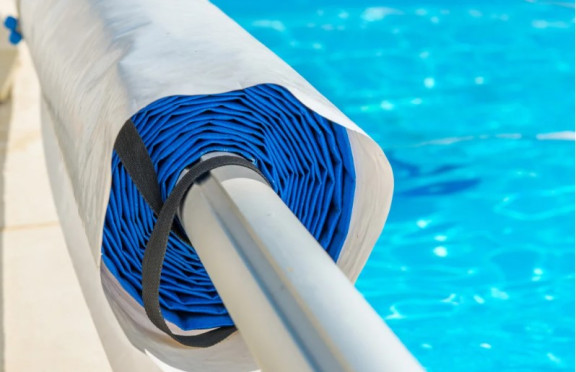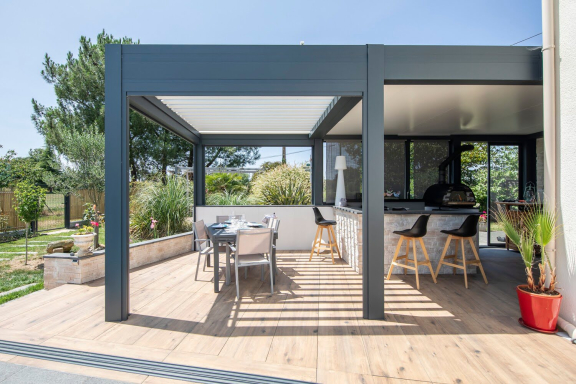How should you store your pool cover?
For your wintering cover when summer comes around or for your summer cover at the end of your pool season, it's important to take time to store your pool cover properly (whether it's a bubble cover, a 4-seasons cover, a wintering cover, a safety cover, etc.). The service life of your pool cover and the ease with which you can use it again to protect your pool water over the next season depends on how well and how carefully you store it. The good news though is that, it only takes a few steps to storing your cover correctly if you use best practices and anyone can do it.
How should you remove the cover from your pool?
The first thing you need to do before storing your pool cover is to remove the wintering cover, bubble cover, solar cover or 4-seasons cover that's still protecting your pool from evaporation, from dirt and debris that harm the quality of water and from the development of algae along the pool sides. Generally-speaking, to remove your cover, you need to remove the fastening systems and/or straps around your oval, round or rectangular protective cover, then lift up the cover so it moves out of its original position. To make things easier, it's better for at least two people to perform this task, especially when the pool cover is of a significant size. Once you've moved the cover away from its original position, you can lay it temporarily on the ground to check it isn't damaged, etc. before storing it away.

Check the condition of your pool cover
When it's placed over your pool (in-ground or above-ground pool), the pool cover is rarely inspected to check its quality and the overall condition of its finishes even though it's an indispensable accessory for your pool. To make sure that your cover has no major defect that could impact its performance and service life, it's highly-recommended, at this stage, to check the overall condition of your cover. To better inspect your pool cover, quickly remove any dead leaves and impurities that have accumulated on the surface. Then, remember to check the condition of the elasticated bungee cords and the fastening system, eyelets, etc. If need be, anticipate repairs by buying replacements for the items damaged (fastening accessory kits can be purchased on the market) and by repairing everything that needs to be repaired before storing your cover. It's always more pleasant to roll out a ready-to-use, easy-to-install pool cover on D-day rather than spend time having to repair your pool cover before being able to use it.
Clean your pool cover
Cleaning your pool cover is one of the keys to ensuring a long service life for this type of equipment. Over time, impurities (debris like dead leaves, insects, etc.) and algae can leave marks on your pool cover. By cleaning your pool cover regularly when it's being used and cleaning it thoroughly at the end of your pool season (for solar covers and bubble covers) or at the end of the pool wintering season (for wintering covers), you'll ensure your pool cover is just as effective as when you first bought it and will continue to ensure your pool water stays at the right temperature, your pool's protected from dirt and dead leaves and that water doesn't evaporate. To do this task, all you need is some bleach diluted in water, gloves, a brush, clean water and a bit of elbow grease to get rid of the stains. You don't need to use any other chemical products or special treatment products to obtain a perfectly-clean cover. Drying your pool cover
Now that your pool cover is clean and has been thoroughly rinsed with a hose or power jet, you need to leave it to dry completely before you store it. Like a lot of pool equipment, the protective cover doesn't like humidity when it's stored in a plastic bag that's sealed or in a storage case. If you can, lay out your pool cover over a large-sized drying rack to help it dry better? In any event, be careful where you decide to place your cover? Make sure, in particular, that it's not lying over any pointed object that could pierce it. If you have no other alternative but to leave your pool cover to dry on the ground, make sure you don't walk on it.
Roll or fold your pool cover
Now that your pool cover is completely dry, you need to get it ready to store. For this task, two techniques can be used; rolling up your pool cover (which you can also do with a roller-winder and a crank handle) or folding it, like you would fold a bedsheet or quilt cover. Although, in practice, it's often easier to fold the pool cover, many professionals recommend rolling it for storage. If you fold it, there's more chance you can damage your cover and as such it won't be as resistant the next time you use it to cover your pool. The best thing to do is to install a motorized roller system so you can delegate this task to a machine that will roll it perfectly. Irrespective of the solution you choose, this step is vital for ensuring your cover is easy to install on your pool for the next wintering season or the next pool season!
Storing your pool cover
You should ideally store your pool cover in a clean, dry, well-ventilated place, far from dirt and humidity. Garages, pool or garden sheds, an equipment room or a basement are generally considered as the best places for storing your pool cover. To avoid nuisance caused by rodents, it's advisable to store your pool cover high up (on a shelf, for example). If and when you can, always use the original pool cover storage bag as a container. Once the pool cover has been put away and stored, you can now start looking after your pool water (treatment) and the pool itself (cleaning)!


